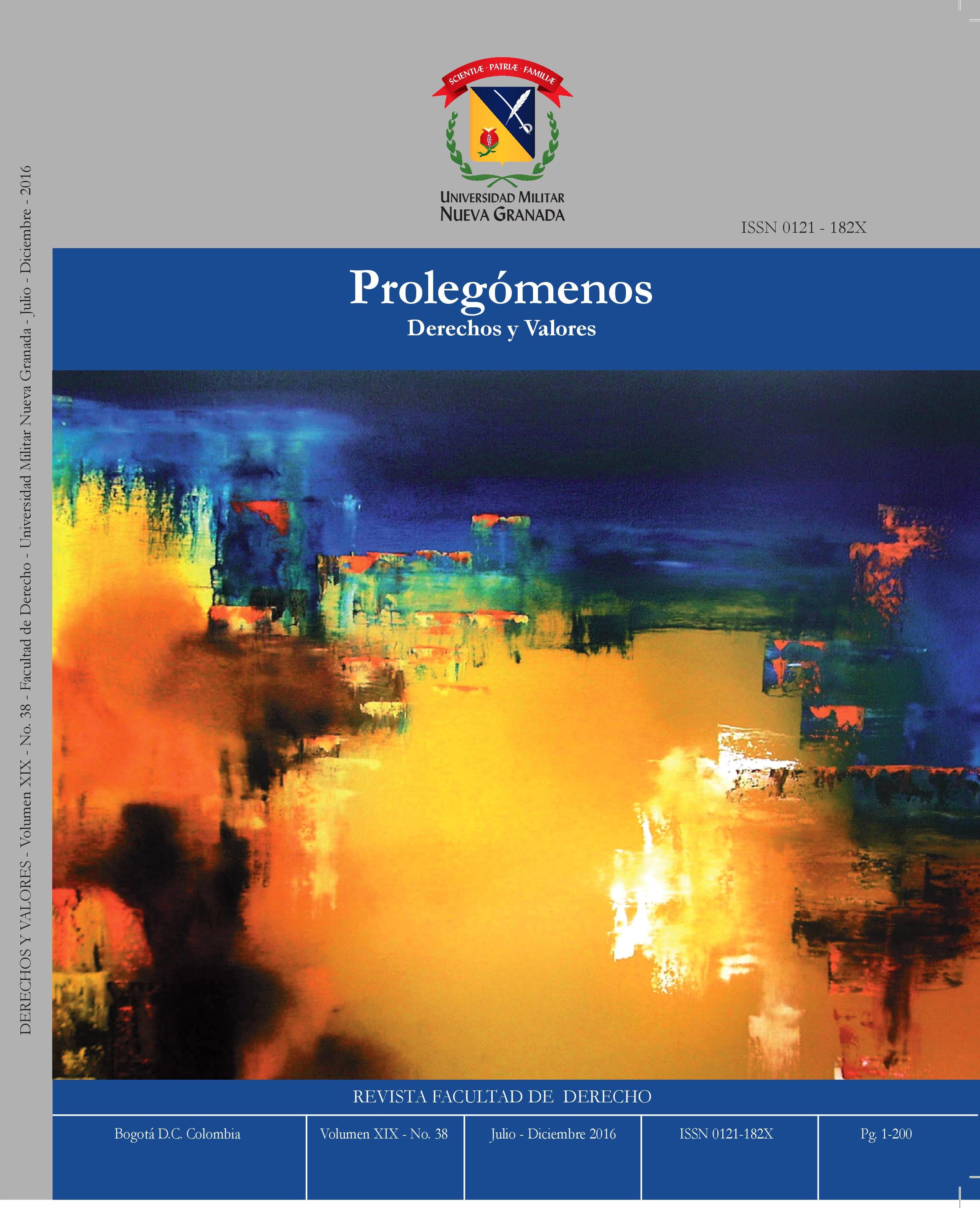Rechazo a los refugiados: políticas de los estados para combatir los flujos de refugiados y responsabilidad de proteger
Resumen
El propósito del artículo es analizar las políticas que están siendo desarrolladas por los Estados para contener o rechazar los flujos de migrantes que tocan su puerta en busca de refugio. En el intento de encontrar una solución a este problema, se examina la posibilidad de hacer uso de los pilares de la responsabilidad de proteger para que la comunidad internacional sea capaz de concentrarse en aquellas situaciones que originan los flujos de refugiados y, de esta manera, parar con las violaciones a los derechos humanos, que los refugiados tengan un retorno seguro y mejorar la calidad de vida de la población afectada, para que ya no esté obligada al éxodo. El método de abordaje es el deductivo, es decir, la aplicación de principios a casos particulares. El artículo muestra cómo las políticas de los Estados están siendo diseñadas para impedir el ingreso de refugiados en sus territorios.
Descargas
Referencias bibliográficas
Alborzi, M. (2006). Evaluating the effectiveness of international refugee law: the protection of iraqi refugees. Boston: Martinus Nijhoff Publishers.
Alto Comisionado de las Naciones Unidas para los Refugiados. (2006a). La situación de los refugiados en el mundo: desplazamientos humanos en el nuevo milenio. Icaria Editorial.
Alto Comisionado de las Naciones Unidas para los Refugiados. (2006b). Statement by Ms E. Feller, Assistant High Commissioner for Protection. Disponible en: http://www.unhcr.org/cgi-bin/texis/vtx/home/opendocPDFViewer.html?docid=4524bc952&query=Handbook%20on%20Voluntary%20Repatriation:%20International%20Protection
Alto Comisionado de las Naciones Unidas para los Refugiados. (2014). Mid-year trends 2014. Disponible en: http://www.acnur.org/t3/fileadmin/scripts/doc.php?file=t3/fileadmin/Documentos/Estadisticas/2014/9985
Alto Comisionado de las Naciones Unidas para los Refugiados. (2015). Acnur pide acción urgente ante nueva tragedia en el Mediterráneo. Disponible en: http://www.acnur.org/t3/noticias/noticia/acnur-pide-accion-urgente-ante-nueva-tragedia-en-el-mediterraneo/
Betts, A., Loescher, G. & Milner, J. (2012). The United Nations High Commissioner for Refugees (UNHCR): the politics and practice of refugee protection (global institutions). Oxford: Routledge.
Carlier, J., Vanheule, D., Peña, C. & Hullman, K. (1997). Who is a refugee? A comparative case law study. La Haya: Kluwer Law International.
Clark, T. & Simeon, J. (2014). UNHCR international protection policies 2000-2013: from cross-road to gaps and responses. Refugee Survey Quarterly, 33(3), pp. 1-33.
Convención sobre el Estatuto de los Refugiados. (1951). 28 de julio.
Dauvergne, C. (2008). Making people illegal: what globalization means for migration and law. Cambridge: Cambridge University Press.
Co-Chair’s Statement (2011). Fourth Bali Regional Ministerial Conference on people smuggling, trafficking in persons and related transnational crime. Disponible en: http://www.unodc.org/documents/southeastasiaandpacific/2011/04/som-indonesia/110330_FINAL_Ministerial_Co-chairs_statement_BRMC_IV.pdf
Declaración de Tlatelolco sobre Acciones Prácticas en el Derecho de los Refugiados en América Latina y el Caribe. (1999). 11 de mayo.
Foster, M. (2007). International refugee law and socio-economic rights: refuge from deprivation. Cambridge: Cambridge University Press.
Foster, M. (2012). The implications of the failed Malaysian solution: the Australian high court and responsibility sharing at international law. Melbourne Journal of International Law, 13(1), pp. 395-423.
Hathaway, J. (1990). A reconsideration of the underlying premise of refugee law. Harvard International Law Journal, 31(1), pp. 129-183.
Hathaway, J. (1991). The law of refugee status. Toronto: Butterworths.
Hathaway, J. (1998). Can international refugee law be made relevant again? Law Quadrangle Notes, 41(3), pp. 106-108.
Hathaway, J. (2007). Why refugee law still matters. Melbourne Journal of International Law, 8(1), pp. 89-103.
International Commission on Intervention and State Sovereignty. (2001). The responsibility to protect: report of the International Commission on Intervention and State Sovereignty. Ottawa: International Development Research Centre.
James, P. (2014). Faces of globalization and the borders of states: from asylum seekers to citizens. Citizenship Studies, 18(2), pp. 208-223.
Kelley, N. (2007). International refugee protection challenges and opportunities. International Journal of Refugee Law, 19(3), pp. 401-439.
Kneebone, S. (2009). Introduction: refugees and asylum seekers in the international context. Rights and realities. En: S. Kneebone (ed.). Refugees, asylum seekers and the rule of law: comparative perspectives (pp. 1-31). Cambridge: Cambridge University Press.
Kneebone, S. (2014). The Bali process and global refugee policy in the Asia-Pacific region. Journal of Refugee Studies, 27(4), pp. 596-618.
Millbank, A. (2000). The problem with the 1951 Refugee Convention. Research Paper, 5. Disponible en: http://www.aph.gov.au/About_Parliament/Parliamentary_Departments/Parliamentary_Library/pubs/rp/rp0001/01RP05
Orchard, P. (2010). The perils of humanitarian: refugee and IDP protection in situations of regime-induced displacement. Refugee Survey Quarterly, 29(1), pp. 38-60.
Organización de las Naciones Unidas. (2001). Asamblea General. Resolución 60/1: World Summit Outcome. Disponible en: http://www.un.org/summit2005/documents.html
Organización de las Naciones Unidas. (2004). Direitos humanos e refugiados. Ficha Informativa, 20.
Organización de las Naciones Unidas. (2009). Asamblea General. Resolución 63/677: hacer efectiva la responsabilidad de proteger. Disponible en: http://www.un.org/es/comun/docs/?symbol=A/63/677
Protocolo sobre el Estatuto de los Refugiados. (1967). 31 de enero.
Saltman, E. & Winter, C. (2014). Islamic State: the changing face of modern jihadism. Disponible en: http://www.quilliamfoundation.org/wp/wp-content/uploads/publications/free/islamic-state-the-changing-face-of-modern-jihadism.pdf
Türk, V. (2013). The UNHCR’s role in supervising international protection standards in the context of its mandate. En: J. Simeon (ed.). The UNHCR and the supervision of international refugee law (pp. 39-58). Cambridge: Cambrigde University Press.
Universidad de Upsala. (s. f.). UCDP/PRIO armed conflict dataset. Disponible en: http://www.pcr.uu.se/research/ucdp/datasets/ucdp_prio_armed_conflict_dataset/
Western, J. & Goldstein, J. (2011). Humanitarian intervention comes of age: lessons from Somalia to Libya. Foreign Affairs, 90(6), pp. 48-59.
Zaum, D. (2011). Post-conflict Statebuilding and forced migration. En: A. Betts & G. Loescher (eds.). Refugees in international relations (pp. 285-304). Oxford: Oxford University Press.











